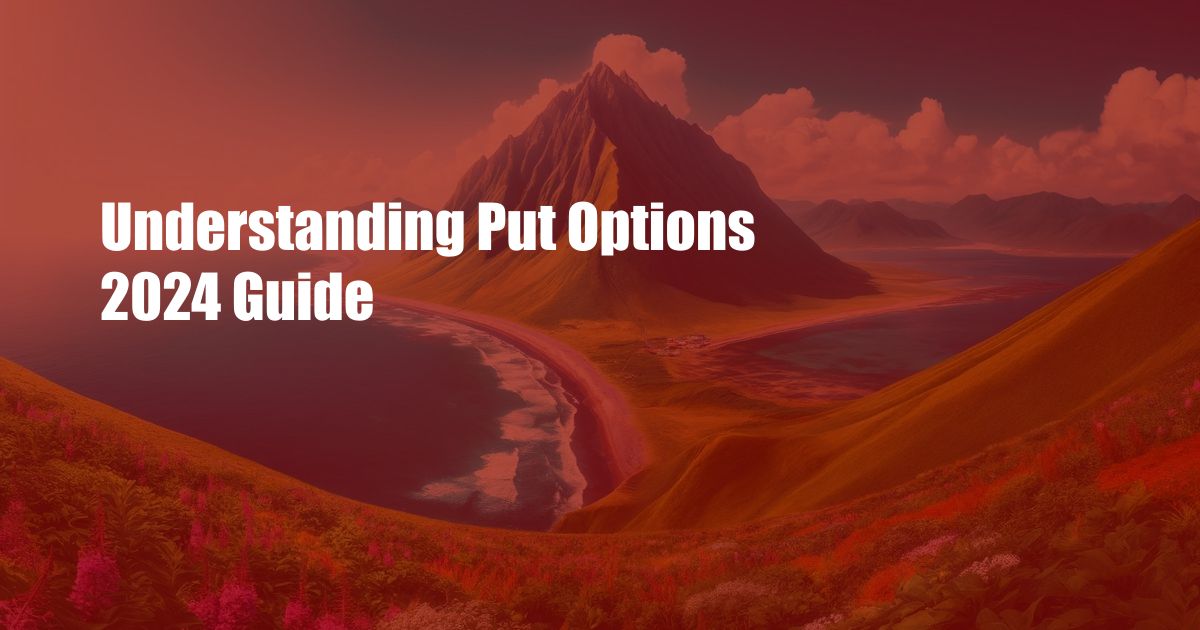
Understanding Put Options 2024 Guide
The world of options trading can be complex and daunting, but understanding the basics of put options is essential for any investor. In this comprehensive guide, we will delve into the intricacies of put options, explaining their definition, history, and significance, while also exploring the latest trends and developments in this dynamic field.
Put options are a type of financial contract that gives the buyer the right to sell a specific asset at a certain price within a specific time frame. In contrast to call options, which give the buyer the right to buy an asset, put options grant the right to sell. This unique characteristic makes put options a valuable tool for hedging against potential losses or speculating on asset price declines.
Types of Put Options
Two main types of put options exist:
- American Put Options: American put options can be exercised at any time before their expiration date. This flexibility provides additional opportunities for investors to adjust their strategies based on market conditions.
- European Put Options: European put options can only be exercised on their expiration date. This restriction limits investors’ ability to capitalize on short-term price fluctuations.
How Put Options Work
When an investor purchases a put option, they are essentially entering a contract with the option seller. The contract specifies the following key terms:
- Underlying Asset: The asset being traded, such as a stock, bond, or commodity.
- Strike Price: The price at which the investor can sell the underlying asset.
- Expiration Date: The date on which the option expires and can no longer be exercised.
- Premium: The price paid by the investor to purchase the option.
Put options are typically used when the investor expects the underlying asset’s price to decline. If the price falls below the strike price, the investor can exercise the option and sell the asset at a higher price than the current market price, securing a profit. However, if the price rises above the strike price, the option expires worthless, and the investor loses the premium paid.
Key Considerations for Put Options
Several key factors should be considered when trading put options:
- Market Volatility: High market volatility increases the potential for price fluctuations, making put options more valuable.
- Expiration Date: Longer expiration dates provide more time for the underlying asset’s price to decline, increasing the likelihood of a profitable trade.
- Premium Cost: The premium paid for the option should be weighed against the potential profit to ensure a reasonable return.
Expert Tips for Trading Put Options
To enhance your put option trading, consider incorporating these expert tips:
- Thorough Research: Understand the underlying asset, market conditions, and the specific characteristics of the option being traded.
- Risk Management: Determine your risk tolerance and limit your investment to a level you are comfortable with losing.
- Hedging Strategy: Use put options as part of a hedging strategy to protect your portfolio against potential losses.
By adhering to these tips, you can increase your chances of success in put option trading. Remember, however, that options trading involves significant risk and should only be undertaken by experienced investors.
FAQ on Put Options
Here are some frequently asked questions and concise answers about put options:
- Q: What is the difference between a put option and a call option? A: Put options give the buyer the right to sell an asset, while call options give the right to buy an asset.
- Q: What are the advantages of investing in put options? A: Put options offer the potential to profit from asset price declines, hedge against losses, and enhance trading strategies.
- Q: What factors should be considered when selecting put options? A: Factors include underlying asset, strike price, expiration date, premium cost, and market volatility.
Conclusion
This comprehensive guide provides a foundation for understanding put options, their significance, and how they can be used effectively in trading. By leveraging the information and insights presented here, you can equip yourself with the knowledge and skills necessary to navigate the dynamic world of put options.
Are you interested in further exploring the intricacies of options trading? If so, consider continuing your research and engaging with experienced traders or financial advisors to enhance your understanding and trading acumen.







